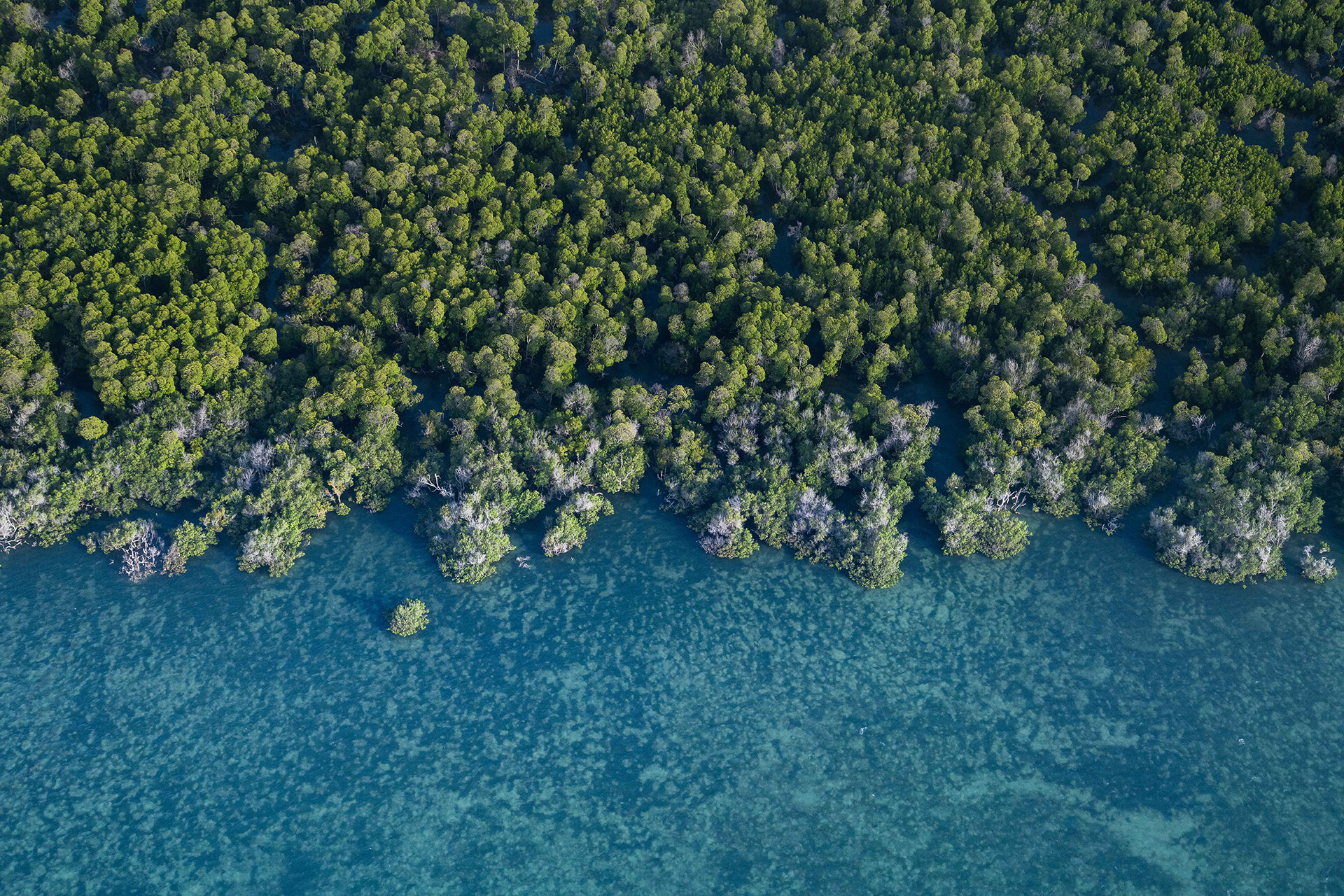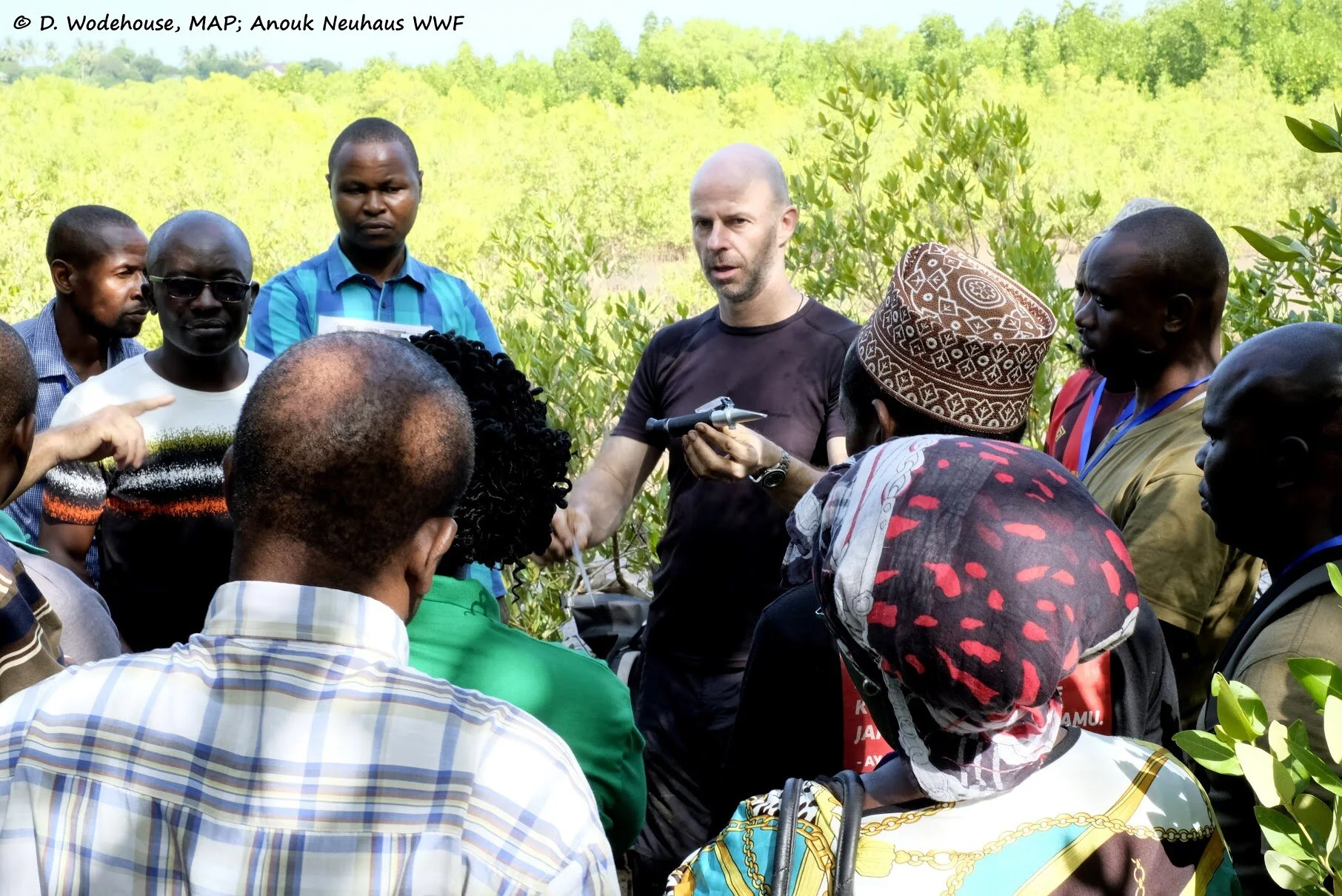Mangrove Conservation in the Community
Josh Pysanczyn
Mangrove Action Project utilises a bottom-up approach to mangrove conservation and restoration through the implementation of their ‘Community-Based Ecological Mangrove Restoration (CBEMR) technique. Through this holistic approach, their aims are to empower local stakeholders and communities, teaching them how to use mangrove ecology and biology to facilitate the forests’ natural regeneration.
Using photographs from Mangrove Photography Awards 2020, we hope to provide an insight into the crucially important workshops and projects that The Mangrove Action Project undertake across the world. The MAP strive to provide degraded mangrove forests a new lease of life and conserve an ecosystem which is essential both humans and wildlife.
Dr. Dominic Wodehouse (Executive Director of Mangrove Action Project) undertakes local training as part of MAP’s ‘Community-Based Ecological Mangrove Restoration’ (CBEMR) technique. Photo: ©Dominic Wodehouse.
A participant from Tanzania’s Forest Service uses a mangrove ID chart to learn new species of mangrove. Phgto: ©Dominic Wodehouse.
The Mangrove Action Project
In 1992, after witnessing first-hand the destruction of the worlds mangrove forests and the impacts that this destruction has on coastal ecosystems, communities and wildlife, a coalition of mangrove conservation advocates took it upon themselves to form a global network to save mangroves, and Mangrove Action Project was born.
A mangrove forest on the Pate Islands, Kenya. Rangers and Fishermen on Pate Island. Photo: ©Roshni Lodhia/MAP Mangrove Photography Awards.
The project first gained momentum tackling one of the greatest threats to mangrove forests: the shrimp aquaculture industry. Their condemnation of the industry spotlighted its destructive expansion, responsible for the loss of hundreds of thousands of hectares of mangrove forest. To learn more about the destruction caused by shrimp aquaculture and the many other threats posed against mangrove forests, visit last week’s blog ‘Threats to Mangroves – Mangrove Action Project’.
Although still heavily involved in advocacy, Mangrove Action Project now focuses its attention to workshops, activities and programmes on the ground, developing community led restoration projects which seek to conserve and rebuild mangroves from the bottom up.
Community Based Ecological Mangrove Restoration (CBEMR)
The CBEMR method is derived from the Ecological Mangrove Restoration (EMR) approach developed by conservationist and activist Robin Lewis. This approach steered mangrove restoration away from the conventional wisdom of ‘gardening’ – building a nursey, growing seedlings, and replanting mangroves – towards the restoration of fundamental ecological processes, such as the hydrology, and seed propagation success, that once enabled healthy mangroves to thrive, and as such, would allow the natural restoration of the mangrove forest.
Gen M for Mangrove. Photo: ©Victor Fidelis Sentosa/MAP Mangrove Photography Awards.
The addition of the ‘Community Based’ element is a vital step in ensuring local community participation and stewardship, safeguarding this fundamental knowledge both between and within developing coastal communities. This holistic approach may include local or international NGO’s, Environment or Forest Department staff, local government staff and other local interested groups.
The communities’ involvement starts with the planning, through implementation, right the way through to follow up checks, monitoring and management. This way, local coastal communities are empowered to become stewards of the mangrove, taking ownership of the restoration project and maintaining the long-term benefits of the ecosystem.
Mangrove Tree Planting. Photo: ©Staffan Windstrand/MAP Mangrove Photography Awards.
Mangrove Tree Planting. Photo: ©Staffan Windstrand/MAP Mangrove Photography Awards.
Mangrove Tree Planting. Photo: ©Staffan Windstrand/MAP Mangrove Photography Awards.
This community orientated approach also promotes, encourages and educates local people on the sustainable, alternative livelihoods that mangrove forests provide. The development of apicultures in mangrove forests along the Andaman Coast of Southern Thailand, for instance, has promoted a sustainable and economically viable alternative livelihood, whilst enhancing the ecosystem services provided by mangrove forests. For more information on mangrove forest ecosystem services, and the development of apicultures in Thailand, why not visit Mangrove Action Project – Ecosystem Services (link to article) to learn more.
The Mangrove Action Project have teamed up with villagers of Nai Nang on the Andaman coast of Southern Thailand to succefully develop apicultures as an alternative livelihood and enhance mangrove ecosystem services. Photo: ©Dominic Wodehouse/MAP.
Pause Before You Plant
To emphasise the importance of informed mangrove restoration, members of IUCN SSC Mangrove Specialist Group, including Mangrove Action Project’s executive director and lead trainer, Dr Dominic Wodehouse, have come together to produce ‘Pause Before You Plant’. This short article considers approaches to planting mangrove trees in association with mangrove restoration, highlighting the importance of protecting old growth forest and the considerate planting of diverse mangrove tree species in the appropriate ecological area.
The first concern raised is that a focus on tree planting draws attention away from something far more pressing: to conserve what we have. As it is suggested that old growth mangrove forests hold around 6.4 billion metric tonnes of carbon in their soil and biomass, the removal of these mangrove forests will result in a mass release of carbon into the atmosphere. In fact, between 2000 and 2015, up to 122 million tonnes of this carbon was released because of global mangrove forest destruction.
It’s essential that conservation efforts are focused on protecting the forests that we already have. Here, Dr Dominic Wodehouse leads a demonstration on measuring mangrove soil salinity. Photo: ©Dominic Wodehouse/MAP.
Secondly, a major issue with mass mangrove tree planting is that the resulting forest tends to lack in diversity. Mass planting projects often focus on one or two species that are easy and fast to plant, creating a ‘short fix’ to mangrove loss.
“The problem with many reforestation efforts is that when saplings are replanted, only one or two species are normally considered, which reduces the mangroves diversity. Subsequently, when there’s a pest or disease outbreak, or when exposed to climate change and global warming, you lose hundreds of thousands of hectares in one swoop”, says Wodehouse.
It is of paramount imporantance to include a diverse array of species when including replanting propagules as a tool in mangrove restoration. ©Dominic Wodehouse/MAP.
The third issue is that a lot of restoration projects lack, or don’t utilise, the correct ecological knowledge, resulting in mangrove tree saplings being planted in the incorrect location in which the tree is adapted to survive.
“Mangroves like to grow in the top half, or possibly the top third, of the intertidal zone, that is, from the average sea level up to the high-water level. Within that half of the zone, each species has different areas in which they are adapted to live, some more towards the landward zone, and others down in the bottom half of the seaward zone”, says Wodehouse.
He adds that, “what happens in a lot of restoration projects is that they tend to plant all their species in the bottom half of the seaward zone and downwards - the mudflats and seagrass meadows - which are not only valuable ecosystems of their own, but have never supported mangrove trees and are ecologically unsuitable for mangrove growth”.
The key to mangrove restoration is a thorough understanding of the ecological processes which enable natural regeneration of mangrove forests, a methodology utilised in Mangrove Action Project’s CBEMR approach. Photo: ©Dominic Wodehouse/MAP.
Mangrove Forest Restoration
Mangrove Action Project’s primary objectives when restoring mangrove forests are the conservation of old growth forest and community based ecological mangrove restoration (CBEMR). However, sometimes it makes sense to actively plant trees.
For instance, in areas where there is an ever-present threat from tropical storms, such as the Philippines, coastlines and coastal communities who experience mass mangrove deforestation are left vulnerable to natural disasters. The planting of naturally available saplings, in conjunction with ecological mangrove restoration techniques have restored mangrove cover to abandoned aquaculture ponds at a much faster rate than the 15-20 years needed by natural regeneration alone.
Villagers in Thailand involved in CBEMR workshops have seen a noticable increase in both vertebrates and invertebrates at each restoration site. Photo: ©Dominic Wodehouse/MAP.
So, “planting mangroves is not bad per se, but planting the wrong species in the wrong place is”, concludes the mangrove specialists in their ‘Pause Before You Plant’ article. Which seems obvious, in theory, but in practice and management, evidently difficult.
This is where Mangrove Action Project fills the educational gap in mangrove reforestation curriculum, so to speak. Through the empowerment of local communities and stakeholders through their CBEMR workshops, projects and educational programmes across the world, including Tanzania, Myanmar, Suriname, Indonesia, Honduras, and Thailand, The Mangrove Action Project is educating and conserving mangrove forests from the bottom up, ensuring the preservation of community livelihoods and safeguarding the world’s mangrove forests now and for the future.
Healthy, biodiverse mangrove forests are home to both large marine and terrestrial fauna. “Jaguars in mangroves: a relationship rarely seen. This mother named “Janis” in an intimate moment with her cub, is a mangrove resident and has reproduced at least three times. Research teams have monitored jaguar (Panthera onca) populations in mangroves in Nayarit, western Mexico.” Once again Being a Mother ©Victor H. Luja Molina/MAP Mangrove Photography Awards.
This year’s Mangrove Photography Awards is open for entries! Check out and get involved in the international photography competition aimed at shining a light on one of our most undervalued ecosystems on the planet; mangrove forests.













